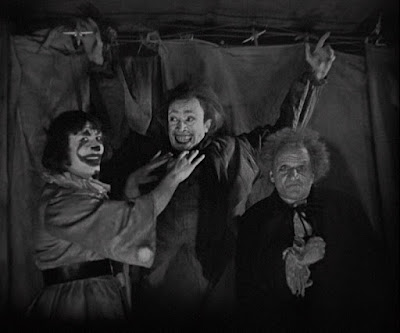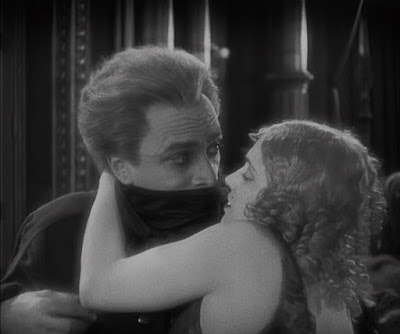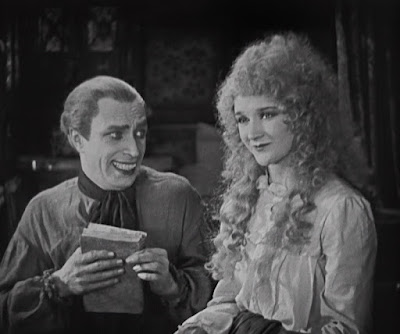(1928) Directed by Paul Leni; Written by J. Grubb Alexander (Adaptation) and Walter Anthony (Titles); Based on the novel L'Homme Qui Rit by Victor Hugo; Starring: Conrad Veidt, Mary Philbin, Olga Baclanova, Brandon Hurst, Cesare Gravina, Stuart Holmes and Josephine Crowell; Available on Blu-ray and DVD
Rating: ****
“A woman has seen my face and yet may love me! If such a thing is possible, then I have the right to marry Dea.” – Gwynplaine (Conrad Veidt)
Note: The following review is an expanded version of a
capsule review from September 2013.
Cruelty and love are two things that know no bounds. The protagonist of Victor Hugo’s politically charged period piece, experiences both, albeit not in equal measures. Universal’s big-budget 1928 version* cast the largely unknown (to American audiences) German actor, Conrad Veidt,** while his fellow countryman, Paul Leni (The Cat and the Canary),*** handled the directing chores. The Man Who Laughs represented a transitional phase, when movie theaters were gradually gearing up for talkies. As a result, two versions were released: standard silent, and a music score**** with limited sound effects.
* Fun Fact #1: Hugo’s story had been filmed at least twice before, as a 1909 French short (now presumed lost), and a 1921 Austrian feature, Das Grinsende Gesicht (aka: The Grinning Face).
** Fun Fact #2: The film was originally envisioned as a vehicle for Lon Chaney, as the logical follow-up to The Hunchback of Notre Dame (also based on a Hugo story) and The Phantom of the Opera, but it had to be recast when Chaney left Universal for MGM.
*** Fun Fact #3: Something to file away in the “What Could Have Been” department – Universal considered Dracula directed by Leni and starring Veidt in the title role. If not for Leni’s untimely death from blood poisoning in 1929, along with The Man Who Laugh’s tepid reception at the box office, it’s possible we could have seen a very different version of the classic 1931 horror film.
**** Fun Fact #4: The partial sound version includes the ditty
“When Love Comes Stealing,” featured prominently in a montage with the two
leads, reminding us that an obligatory sequence with a would-be hit song is
nothing new in Hollywood.
After arranging the capture of Lord Clancharlie (also played by Veidt), who’s fallen out of favor with King James II (Sam De Grasse), the treacherous jester Barkilphedro (Brandon Hurst) concocts a plan to remove Clancharlie’s son Gwynplaine (the rightful heir to the throne) from the picture. The child is sold off to Comprachicos (a Spanish-derived term created by Hugo, meaning “child buyers),* and disfigured by one of their surgeons. When the Comprachicos are banished from England, young Gwynplaine (Julius Molnar, Jr.) is abandoned and left to die in a frozen wasteland. He rescues a baby girl, still clutched in her dead mother’s embrace, and makes his way to a circus wagon. Both children are taken in by Ursus (Cesare Gravina), a kindly performer. Skip forward several years, and the adult Gwynplaine and blind orphan named Dea (played by Mary Philbin, who co-starred with Lon Chaney in Phantom of the Opera), roam England with Ursus in a traveling sideshow. Gwynplaine’s show catches the attention of the scheming Duchess Josiana, played by Russian-born Olga Baclanova (best known for her role as the deceitful trapeze artist Cleopatra in Freaks). As the lowly Gwynplaine’s fate intersects with the aristocracy and he becomes their pawn, he endeavors to find his true destiny.
* It’s worth noting that evidence suggests the Comprachicos
(who were supposedly Romani in origin) never existed – making this an unfortunate
effort, on Hugo’s part, to demonize Romani people for the purpose of his story.
In one scene, in which Gwynplaine is summoned to Josiana’s bedroom, she seduces him, evoking conflicted emotions. As someone accustomed to being the object of derision, he wrestles with her sudden interest in him, nearly succumbing to her advances. There’s something distinctly Freudian (Madonna/Whore Complex) about his attitude toward Josiana and Dea. While Dea represents his ideal of virtuous, almost asexual love, Josiana is pure libido. Baclanova takes every opportunity to vamp it up, chewing the scenery like it’s her last meal. She provides an almost irresistible temptation for Gwynplaine, who’s likely never experienced any carnal pleasures. Josiana displays a fetishistic infatuation with his disfigurement, which excites and repels him. In comparison, Philbin’s role is much more passive, as she emotes and pines away for Gwynplaine. His love for Dea is less about the pleasures of the flesh, and more about gaining her unconditional acceptance (even though she clearly adores him). Compared to Baclanova’s flashier antics, the top-billed Philbin comes up a bit short. In all fairness, however, Dea’s function, story-wise, is considerably more limited.
In an effort to puff up the mystique surrounding Gwynplaine’s
appearance, studio publicists touted that Veidt only wore minimal makeup, instead
creating the character’s distinctive look through his alleged mastery of facial
musculature (deemed “muscular makeup”). While there is a kernel of truth to the
studio propaganda, much of Gwynplaine’s appearance can be attributed to Jack
Pierce’s (responsible for the iconic look of Universal’s monsters in the ‘30s
and ‘40s) makeup. Veidt wore a constrictive mouth appliance, which included
false teeth and hooks to keep his mouth in a grotesque approximation of a grin,
causing considerable discomfort. The actor was unable to speak intelligibly,
but after some practice, learned to create a limited range of mouth expressions.
It’s a testament to his acting prowess that he was able to convey a complete
range of emotions, from elation to abject sorrow (and everything in between)
despite the physical limitations imposed by Pierce’s makeup. As convincing as
the makeup is, it would amount to little, if not for Veidt’s tragically
beautiful performance. His expressive, often tear-stained eyes convey pathos in
every scene. When he’s not on stage, Gwynplaine hides his mouth from everyone,
including Dea (despite her inability to see him). He’s deeply ashamed of his
appearance, trapped in a hideous visage and (at least to his eyes) unlovable.
Leni,* who cut his cinematic teeth as an art director before directing, brought his unique eye for visuals to The Man Who Laughs, with expressionistic flourishes peppered throughout. For his part, Veidt proves it’s not simply the makeup that makes the performer. Although Philbin is overshadowed by Veidt, her co-star Baclanova, and Brandon Hurst (who seems to be having a blast as a jester with a perennial devilish grin), her character serves a vital purpose, proving that kindness prevails. And let’s not forget the unsung hero of the story, Homo the Wolf (played by a German Shepherd named Zimbo), who has a pivotal scene during the film’s climax. It’s easy to see how The Man Who Laughs has influenced other movies and media. Gwynplaine’s unforgettable appearance, with his mouth frozen in a permanent rictus and severely swept back hair, is commonly attributed as the inspiration for Batman’s arch nemesis, The Joker (created by Bill Finger, Jerry Robinson and Bob Kane). Additionally, the “love is blind” theme, ** with a seemingly unlovable person finding love, has been recycled many times (Maybe it was my brief dalliance with Troma films that’s to blame, but it’s not too much of a stretch to draw a parallel between Gwynplaine and Dea with the Toxic Avenger and his blind girlfriend). The film’s conceit that Gwynplaine’s face evokes laughter from all who see him is a litmus test for the other characters’ (and by extension, the audience’s) compassion. While the individual elements may be familiar to modern audiences, The Man Who Laughs persists as a timeless classic because it blends these elements so well.
* Fun Fact #5: Leni reportedly used a three-foot gong to startle his performers into providing the appropriate reaction.
** It seems a bit disingenuous that films often portray a woman who falls for a man with a physical abnormality, and rarely the other way around. It would be nice to see some enterprising filmmaker reverse this time-worn trope for a change.
Sources for this article: “The Face Deceives,” by David Cairns and Fiona Watson; and “Paul Leni and The Man Who Laughs” by John Soister (featurettes on Eureka Blu-ray)







Years ago I read Ray Russell's Sardonicus and loved it. It was clearly inspired by The Man Who Laughs, with the main character suffering the same type of deformity (but from a different cause). William Castle's adaptation, Mr. Sardonicus is just ok. Later, I stumbled upon The Man Who Laughs and was bowled over by it. I've never seen a better silent. It's fun, isn't it, to reflect on the "might have beens"-- I think Veidt would have made a great Dracula!
ReplyDeleteI agree. As my wife pointed out, if Veidt had played Dracula (and not Lugosi), his version would probably be the one venerated by film fans today. I need to look up Sardonicus. I've seen the Castle adaptation, but I've probably only experienced a watered-down retelling.
DeleteFantastic review, Berry!
ReplyDeleteI have seen this film just been a very long time.
I had no idea that Conrad Veidt might have played Dracula. I'm just going to say it, but I think he would have made the film so much better.
Thanks, John! I started this review 8 years ago, then shelved it, in favor of a capsule review. I'm glad I finally finished it (then again, that's just like me to never throw anything away)! ;) Seeing Veidt as Dracula would have been fantastic. I think the world lost something special, when the bigwigs at Universal decided to go with someone else.
DeleteGreat article, Barry. It's been many years since I watched The Man Who Laughs. A rewatch is definitely in order. I never made the connection that it is Olga Baclanova from Freaks as the Duchess. Thanks for the education.
ReplyDeleteThanks, Michael! I'd love to hear your thoughts about this one. Olga Baclanova steals the show from Mary Philbin (who received top billing).
DeleteOne of the reasons I need to give the film a re-watch is I feel I wasn't in the correct mindset the first time I watched it. I was expecting a horror movie so, although I liked the film, it failed to meet those expectations.
Delete